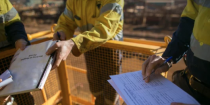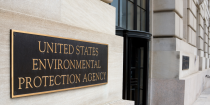Category: Contaminated Property

ASTM Adopts a New Phase I Environmental Site Assessment Standard
Environmental Partner, Sedina Banks, published "ASTM Adopts a New Phase I Environmental Site Assessment Standard" in the Fall 2022 issue of NAIOP's Development Magazine. In her article, she discusses the revisions made to ASTM's Phase I environmental site assessment standard and how it will affect commercial real estate transactions. Sedina...

Even Your Parking Structure Violates Prop 65
The Prop 65 “Clear and Reasonable Warnings” updates that became effective in August 2018 contain lots of traps for the unwary, including one that you might not have noticed: tailored Prop 65 warnings are required at each of the public entrances to your enclosed parking facilities. To avail your regulated...

Superior Court Invalidates Hexavalent Chromium Drinking Water Standard
Earlier this month, Judge Christopher E. Krueger of the Sacramento Superior Court issued an order invalidating the Maximum Contaminant Level (MCL) for hexavalent chromium . The California Department of Public Health (“DPH”) established an MCL of 10 μg/L, or parts per billion (ppb), pursuant to a rulemaking effort that concluded in 2014...

Shell Pays Big for Double Dipping with the UST Fund
Last week, the California State Water Resources Control Board (State Water Board) announced that it permanently banned 100 of Shell Oil Company’s underground storage tank (UST) claims from the California UST Cleanup Fund (Fund) for allegedly claiming reimbursement through false or misleading statements on its claim forms. The State...

The Sunset Will Last a Little Longer - UST Fund Extended
On September 25, 2014, Governor Brown signed SB 445 (Hill) Underground storage tanks; hazardous substances: petroleum: groundwater and surface water contamination into law (UST Law). The UST Law was an urgency measure that took effect immediately. The UST Law makes changes to the Underground Storage Cleanup Fund (UST Fund...
ASTM Issues New Standard For Phase I Environmental Site Assessments
On November 6, 2013, ASTM revised its standard for conducting Phase I environmental site assessments, known as Standard E1527-13 (entitled “Standard Practice for Environmental Site Assessments: Phase I Environmental Site Assessment Process”). ASTM E1527-13 is the first revision to the ASTM Phase I standard since its 2005 revision of the standard (known as...

EPA Issues New Superfund Guidance
Settlement plays a fundamental role in the Environmental Protection Agency’s (“EPA”) Superfund enforcement program. Potentially Responsible Parties (“PRPs”) seeking to resolve their liability through the settlement process should take note that EPA recently issued two new guidance memoranda on its settlement procedures. One memorandum sets forth revised procedures for...
Is Your Vehicle a CERCLA Facility?
While we tend to think of a CERCLA “facility” as the real property where environmental contaminants have come to be located, it is important to remember that CERCLA’s definition of “facility” is actually much broader than that and can serve to open the door to “Potentially Responsible Parties” not considered in...
California State Water Board’s Low-Threat UST Case Closure Policy Is Now Effective
On May 1, 2012, the California State Water Resources Control Board (SWRCB) adopted via Resolution No. 2012-0016 the Water Quality Control Policy for Low-Threat Underground Storage Tank Case Closure (Low-Threat Closure Policy). The Low-Threat Closure Policy finally became effective on August 17th. This should be good news for the thousands of UST sites in California...
Settling Party Barred from Bringing a CERCLA Section 107(a) Claim
This week, in the case of Solutia, Inc. and Pharmacia Corp. v. McWane, Inc. (Solutia), the Eleventh Circuit held that a party that performs a cleanup in compliance with a consent decree has no right under the Comprehensive Environmental Response, Compensation, and Liability Act (“CERCLA”) section 107(a) to recover its cleanup costs...
PERC-ED UP: EPA HAS RELEASED FINAL HEALTH ASSESSMENT
Okay, so it will probably come as no surprise to those readers that know anything about perc (also known as PCE, short for perchloroethylene, another name for tetrachloroethylene – whew!) that, when the U.S. Environmental Protection Agency (EPA) released it’s final health assessment for the chemical this week, EPA essentially concluded “yep, it’s still bad...
State Water Board May Soon Adopt the Low-Threat UST Case Closure Policy
Last week, the California State Water Resources Control Board (SWRCB) gave notice of public opportunity to comment on its proposed April adoption of the Water Quality Control Policy for Low-Threat Underground Storage Tank Case Closure (Low-Threat Closure Policy). This should come as welcome news for the thousands of underground storage tank (UST) sites in...
Happy 30th Superfund
30 years ago tomorrow, Congress passed the Comprehensive Environmental Response, Compensation and Liability Act (CERCLA), which is commonly known as the Superfund law. CERCLA, which Congress amended in 1986, was created to address the most contaminated properties in the United States and to provide federal authority to respond to releases or threatened...
In a Troubled Economy, They Can’t Leave Well Enough Alone
Since 1989, one bright spot for owners of property in California contaminated by petroleum releases from underground storage tanks has been monies available from the State of California Petroleum Underground Storage Tank (“UST”) Cleanup Fund (the “Fund”). Monies in the Fund are provided by a storage fee paid by petroleum...
Making Lemonade Out of Lemons: EPA’s Recent Step Toward The Development of Renewable Energy on Contaminated Properties
In September of 2008 EPA launched its RE-Powering America’s Land initiative with the objective of developing renewable energy on current and formerly contaminated properties. As a result of its 2009 meetings with stakeholders from the renewable energy industry, landowners, state and local governments and others, EPA recently took a significant step toward implementing...
What to do with Superfund, Brownfield Sites? EPA has an answer
Landowners, some reeling after years of costly regulatory scrutiny and enforcement actions, often find themselves at a loss with what to do with Superfund sites, brownfields and former landfills and tapped-out mines. Well, on Feb. 23, the U.S. Environmental Protection Agency offered at least one possible solution: develop renewable...

